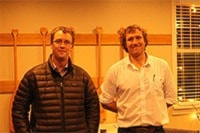Although things may look bleak for the mining industry in the region, there is a glimmer of hope, according to Kyler Hardy, President of Equitas Resources Corp.
Hardy and Jeff Kyba, Regional Government Geologist for the Skeena Region, hosted an open house and presentation at the Burns Lake and District Chamber of Commerce on Nov. 26, 2015.
Representing the Smithers Exploration Group, they spoke to 12 people interested to learn more about mining exploration and investment in our region
Participants took the chance to discuss the recent closure of the Endako Mine and the fact that mine owners Thompson Creek Metals Company Inc. had recently announced their intention to sell. However, they argued that the outlook may not be so bleak.
“The mining industry is very much a boom and bust cycle industry, with periods of extreme wealth creation and periods of extreme wealth destruction,” said Hardy. “Right now we are past the extreme wealth destruction phase, and I would say we’re in the bottom of the cycle right now.”
“If even one [of the proposed] pipelines goes through it will increase the demand for steel,” he said, as increased demand for steel tends to increase the demand for molybdenum.
Hardy asserts that despite the prolonged downturn in the mining industry we are in a unique position in the north and in communities such as Burns Lake to create opportunities.
“Major companies start to build mines in this period because they get cheaper rates on construction,” he said. “Right now it’s a bit tenuous because we are seeing a drop in metal prices in the last couple months; however, the spending that is going on is setting the stage for the next step in the cycle.”
In terms of anyone interested in getting involved in investment at this phase, Hardy urged caution.
“The ones who made large amount of capital in the last boom phase are the ones who are out doing these large exploration projects, and positioning themselves; it’s not a place that I recommend unsophisticated investors to get involved in because it’s basically a shark pool and people get taken very quickly, so just be careful if someone comes running in saying they have a sure thing.”
Hardy described different cycles such as the “new beginnings phase.” This is where large company projects that lay dormant from the last cycle due to insufficient funding start up again as side projects or joint ventures with interested parties - usually with ‘juniors’ who are better at exploration. Juniors refers to small companies that focus on exploration and discovery in the hopes of either mining the resource or selling the rights to a larger cooperation.
“Smart money is either investing or starting new companies around high quality assets usually involving these dormant deals, we’re still not quite seeing this yet.”
This phase is when communities can capitalize on early growth by developing mining industry support services.
“This is when you get to take your diamond drilling companies, take your exploration services, take your expediting group, take your air service group, whatever it is, and basically build a new division that focuses on the exploration opportunities that are out there.”
In the “upwardly mobile phase,” there is a period of accelerated growth. “Everybody’s heard of making the big score and making masses of money off a discovery, that’s when his happens, the masses then start to recognize the opportunity,” he said. “Your neighbours start talking about it.”
However, as Hardy informs the group, this is when industry veterans usually start cashing in their stock.
“They begin to take their chips off the table because they see the market is getting overheated.”
Hardy asserts that this time is unfortunately when most communities first become aware of potential opportunities.
“They start to get interested, when they should be interested in the previous stage, the stage we’re in right now, so they miss the opportunity.”
In the “toping phase,” as Hardy calls it, is when you start to see the “peak.”
“You know you’re in a phase where it’s really time to get out, when your taxi driver starts to give you the latest stock tip, it’s time to get out,” he said. “The smart money is in an exiting period or it’s already gone, basically they leave the suckers holding the bag at the end of the day and it’s part of the cycle.”
Hardy ended his presentation remarking on a potential positive opportunity in the near future for the industry: the prospect of India’s growing economy, which at this point Hardy describes as immature, but could hold potential for growth in Canada and B.C.
“Once it takes off, new middle class economies need the metals that we can supply.”
